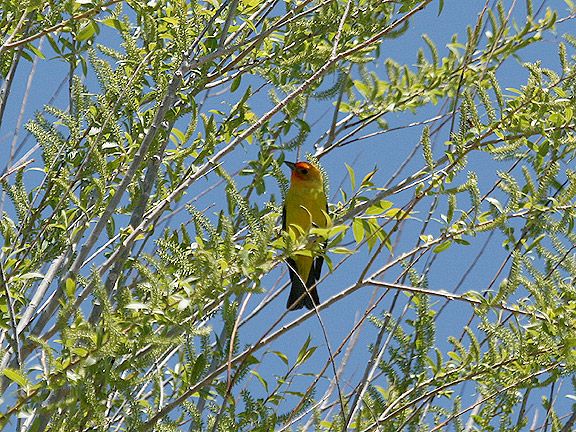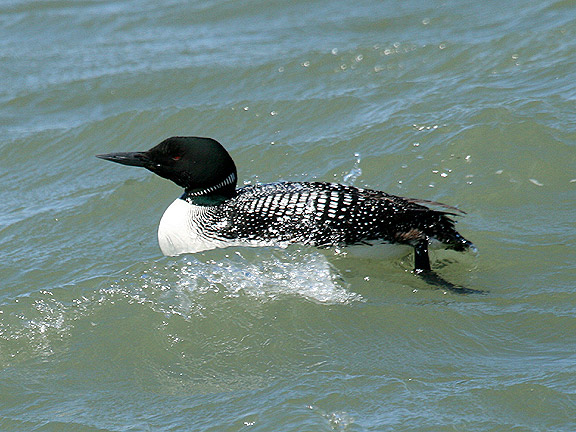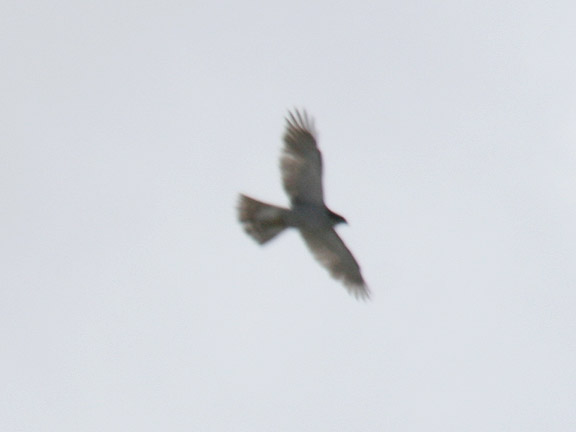Mark Stackhouse has run the Marathon Birding trip for a number of years at the Great Salt Lake Bird Festival and it was always a popular trip. About 5 years ago they decided to offer two versions with me leading another to accommodate the growing number of people interested in the trip. Last year Mark was unable to make it and the festival asked Jeff Bilsky to take on the trip. We decided to team up and lead the two 5 person trips together for a 10 person northern 2/3 Big Day—or Marathon Birding. It just so happened that the 10 person trip ended up outdoing all my previous trips for the total number of species in the day, with 141 tallied by end of day. So this year we decided to team up again and see what would happen again.
Nine people arrived by 6:00am at the festival headquarters in Farmington, along with 2 drivers, 12 Subway sandwiches, 2 cases of water, a host of binoculars, scopes, cameras, bird books and high hopes. After getting everything packed in the cars, signing our lives away, and quick introductions—we kicked off the birding on time with an AMERICAN ROBIN being the first bird of the trip, followed by BROWN-HEADED COWBIRD (both audible), and a fly over group of AMERICAN WHITE PELICANS. Lastly, before we piled into the vehicles Jeff pointed out an OSPREY perched in a dead Cottonwood several hundred yards away—the only Osprey we had for the day!
We drove into Farmington adding a couple “fly-bys” and “run-fasts” before making our first official stop at the ponds at the end of Glover Lane. We added nearly 40 species including a CACKLING GOOSE that has been around for a couple months, a drake BLUE-WINGED TEAL—the only of the day, and a number of other marsh birds. Moving onto Farmington Bay we found the gates closed—keeping us at the entrance to scan the first ponds, adding a few shorebirds, and the only RUDDY DUCK of the day. By 6:50am we were on the freeway headed to Antelope Island, with 50 species already on our list.

Western Tanager, the 2011 Spotlight Species
Driving from Layton to the causeway we added AMERICAN CROW for the group, and the lead car picked up a WESTERN TANAGER speeding across the road in front of us. I heard this was only the 2nd seen up to that point at the festival; a sour note since it was the spotlight bird this year. Once on the causeway we started adding new birds left and right—literally. First, on the left were about 10 LONG-BILLED CURLEW, then on the right 5 WHIMRBEL, a great find for the bird festival and in such numbers for Utah. Next we started seeing BLACK-BELLIED PLOVER—around 600 in total by the time we left. After a little scanning of the flats we turned up about 40 SNOWY PLOVERS around a ½ mile south of the road. Continuing across towards the island, we added both WILSON’S and RED-NECKED PHALAROPE as small flocks flew by and over the causeway in the strong winds.
Once on the island we grabbed CHUKAR, BEWICK’S and ROCK WREN, BREWER’S, LARK, CHIPPING, WHITE-CROWNED, and VESPER SPARROW, LOGGERHEAD SHRIKE, HORNED LARK, BURROWING, GREAT HORNED, and BARN OWL, and finally SAY’S PHOEBE. The only bird we missed that was expected was a Sage Thrasher. On schedule we took off heading for Willard Bay State Park. When we arrived the wind was in full effect as it was throughout the day. We added most of our expected species, with the exception of Gray Catbird and Eastern Kingbird. We missed a handful of more common species and the warbler diversity was slim. We did have 4 WESTERN TANAGER and the best bird of the morning in 4 EVENING GROSBEAK. A single LESSER GOLDFINCH and a beautiful COMMON LOON rounded out the surprises.

Common Loon at Willard Bay State Park
About 45 minutes behind schedule we headed north a little ways to Bear River MBR and drove a couple miles towards the refuge before turning back. We were hoping to turn up a Cattle Egret which we missed along I-15, but no such luck. Hoping to keep somewhat on schedule we headed east through Brigham City, adding RED-BREASTED MERGANSER at Mayor’s Pond before heading up Sardine Canyon and into Cache Valley. We drove up the west side through Mendon crossing the Bear River at Cutler Marsh where we got lucky with an AMERICAN BITTERN about 10 feet off the road. A great bird for the trip that everyone got to see.

American Bittern in Cache Valley
About an hour behind schedule we headed into Logan Canyon where the wind was whipping through the trees. Our normal picnic stop for lunch was closed, so we stopped at the next available location. As we unpacked to eat lunch there was a chattering whistle from the river. We walked in the direction of the sound, finding an AMERICAN DIPPER feeding another dipper. I expected it to be a mated pair but was shocked to find the bird being fed was a juvenile! Even more shocking was when I took my binoculars down and looked about 6 feet in front of us, spotting another young dipper flipping up twigs and leaves on the shore just in front of us! Everyone got great looks and some photos before we left the family to feed and feed ourselves.

American Dipper in Logan Canyon
After a little longer lunch than past years, we packed back up and headed higher into the mountains. We made one stop where we got looks as WHITE-THROATED SWIFT, VIOLET-GREEN SWALLOW, and SHARP-SHINNED HAWK. Continuing upward to where snow pack was still on both sides of the road, we stopped at Franklin Basin Road, just below Beaver Mountain where the surprise was nearly 50 “PINK-SIDED” DARK-EYED JUNCO. Usually we see a few Gray-headed, but the Pink-sided were a nice surprise. RED-NAPED SAPSUCKER, NORTHERN FLICKER, TOWNSEND’S SOLITAIRE, and HOUSE WREN were welcome additions before we made our way up to Beaver Mountain Ski Resort where the wind was howling and the birds were quiet.
A lone RUBY-CROWNED KINGLET sang away from one stand of conifer, while a flyover group of CASSIN’S FINCHES were heard by a couple of us. As we climbed the road towards the resort, I spotted what appeared to be a Goshawk. I got out yelling back and Jeff got out thinking he saw the same thing. The bird disappeared out of my sight and Jeff hollered it was a false alarm and just a Red-tailed Hawk. We got back in the car and continued up the hill when not even 100 yards up the distinct shrieking of a NORTHERN GOSHAWK came out of the trees by the road. We again hopped out as I yelled back to the second car about the bird, just in time to see an adult Goshawk soar out of trees chasing and then dive bombing a Red-tailed Hawk. As the birds passes I snagged my camera and managed two distant backlit shots before the hawk disappeared back into the forest.

Northern Goshawk in Logan Canyon
Unfortunately not everyone was able to see the bird as the quick event took place and was over in a matter of seconds. For those who did it was certainly a highlight for the day. After calming back down and finding no more birds at the resort, we headed east, picking up MOUNTAIN BLUEBIRD before dropping out of the mountains and down to Bear Lake. After refueling and almost 2 hours behind schedule we made our way to Sage Creek Junction to head south to Deseret Ranch. At the junction there was a ton of water in what is normally a dry ravine. A single CANVASBACK accompanied 3 REDHEAD, and a few NORTHERN PINTAIL. The Canvasback was our only of the day.
As we headed south now we stopped in Randolph spotting a COMMON GRACKLE perched in a tree in the middle of town. Jeff’s car spotted another as we passed through Woodruff. Hitting dirt road we made our way across Deseret Ranch, adding AMERICAN WIGEON and SAVANNAH SPARROW. The birding was rather slow and a few species were missed. But before we headed over the last hill a GOLDEN EAGLE soared over the road right over the first van, diving on a FERRUGINOUS HAWK, our only of the day and a good way to exit ranch.
Taking a quick dip over the border into Wyoming we visited Woodruff Narrows Reservoir where we tallied 50 species in about 30 minutes, the highlights being our first SAGE THRASHER of the day and a first for our marathon trips—a SAGE SPARROW that most of the group got to see running around with it’s tail straight up in the air. There were more shorebirds than I have ever seen in Wyoming on the south end of the reservoir, most were too far out to ID, but there were quite a few LONG-BILLED DOWITCHERS and both WILSON’S and RED-NECKED PHALAROPE. There were a few birds that I suspected were RED KNOTS, but they were too far out to be sure—and there were a couple hundred birds that were likely peeps, but at well over a mile away it was hard to tell.
With daylight running out, we hit the road, going through Evanston, and back in to Utah for about 70 miles of driving before we finally stopped again at Summit Park to try one last time for some coniferous species. MOUNTAIN CHICKADEE, STELLER’S JAY, and HAIRY WOODPECKER were all added to the list for the day, and a couple GREEN-TAILED TOWHEE gave everyone nice looks. As if the surprises throughout the day weren’t enough we added 3 BUSHTIT that seemingly came out of nowhere and were gone again after only a minute. As 8:00pm rolled around we made our way to Mountain Dell Reservoir, picking up SPOTTED TOWHEE a strange miss throughout the day until that point. With the last half hour of daylight we headed into Salt Lake City, making a pit stop before heading up Millcreek Canyon to go owling.
Unfortunately the wind never stopped once we made it to Desolation Trailhead. We hiked up the trail a ways and got away from the actual wind, but the entire 30 minutes we were there it was on and off in the trees above. This made it hard to hear anything. About half the group heard one or two toots from a FLAMMULATED OWL in between wind bursts, but with the conditions it just wasn’t a good night to keep looking.
And just like that the Marathon Birding trip was over.
132 species, 11,000 individual birds, 350 miles, and whole group of very tired, wind burnt birders called it a day. Looking back it’s astonishing what birds we missed; what birds we saw; and the strange things that seem to happen on days like this.
Take for instance the misses. How about Downy Woodpecker or Cedar Waxwing? Fox Sparrow or Red-breasted Nuthatch? Western Scrub Jay or Hermit Thrush? Those are all species we usually see. What about warblers? We tallied a grand total of 2 species on the day! That seems impossible on the ides of May—during the height of warbler migration; but it’s true. No Yellowthroat, Orange-crowned, MacGillivray’s, Black-throated Gray, or Virginia’s. We managed to miss Ring-necked Duck, and couldn’t turn up any lingering winter waterfowl. No Cattle Egret of Night-Heron. I could go on for a little longer, as there are about 25 species that would seem easy to find in May in northern Utah—but on a “big day” nothing is guaranteed and the Marathon Birding trip proved that year in and out.
The trade offs are the unexpected. The Grosbeaks, the Bittern, the Goshawk, the Bushtits—all make for great memories on these long days. They stand out as the “best birds”. But more interesting are the strange things like the Dipper with two fledglings at 7000’ in mid May. Thinking about it that means that bird was nesting as early as late March when 10’ of snow covered the banks of the river, and the icy water was carving its way down canyon. Seeing the young birds so close and the story that surrounds them getting to this point is more interesting than the rare birds for many people.
Another year and another bird festival in the books; and another Marathon Birding trip in the books. Now back to migration and hopefully some great summer weather!
Labels: big day, fieldtrip, rare birds


















